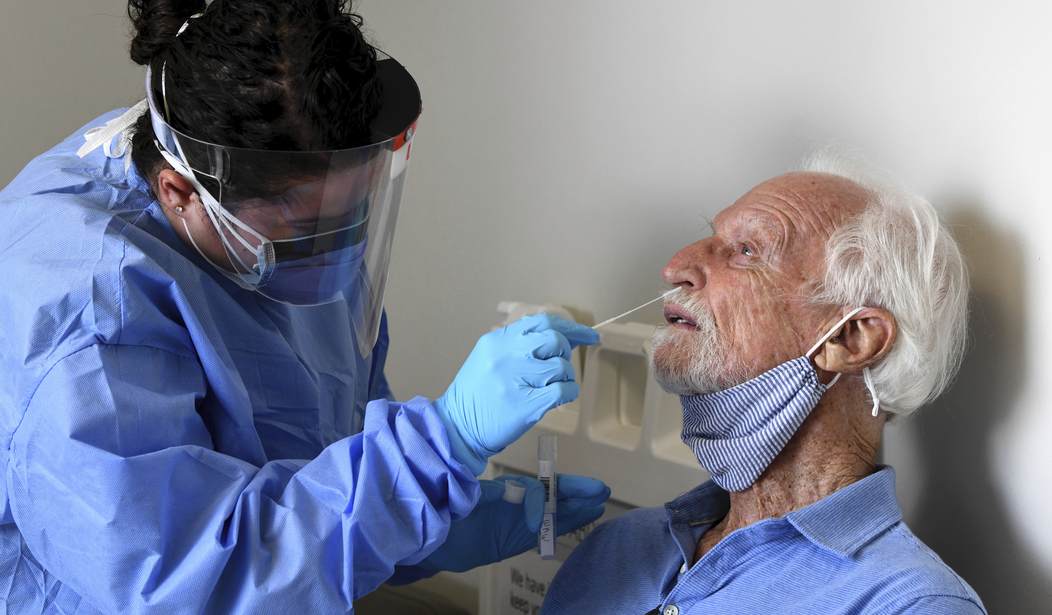With the election, COVID-19 seems to be taking a back seat, other than corporate media outlets breathlessly reporting COVID-19 cases and tin-pot tyrant governors telling you exactly how you may or may not celebrate Thanksgiving based on that metric.
So, here is a rundown, with detailed sourcing, linking to recent news and previous information. The job of media is to inform so people can make individual decisions based on all available information. This is especially important as we move into the season of gathering with friends and loved ones. And Dr. Anthony Fauci, CNN, and Andrew Cuomo are hardly the final word on everything.
Vaccines
There has been good news on vaccines, with a third candidate from Oxford University and AstraZeneca. One dosing schedule demonstrated a 90% effective rate, and there were no COVID-19 related hospitalizations or severe cases in study participants. As with the other two candidates, this appears to be consistent across age groups and racial groups.
Remdesivir and the Treatment of COVID-19
The WHO has issued a conditional recommendation against the use of remdesivir after reviewing data from 7,000 patients enrolled in four randomized controlled trials. This data showed no effect on mortality, the need for mechanical ventilation, the time to recovery, and other patient outcomes. The initial study published by the NIAID, the NIH division run by Dr. Anthony Fauci, also showed no statistically significant impact on mortality.
The need for mechanical ventilation was not reported in the press release, but the study did claim to shorten the median recovery time from 11 days to 15 days. The WHO trials did not replicate these results. But remdesivir’s $3,210 price tag factored in. The justification was that a median of four additional days in the hospital cost more than the drug. It remains to be seen how well that claim holds up.
One individual objecting to the WHO findings is Dr. Ralph Baric, an epidemiologist and researcher from UNC. He asserts that because the patients and doctors knew which drug was being administered in open-label random controlled trials, the studies are flawed. He claims they aren’t as rigorous as double-blind studies, which seems like a stretch given the assessment included the original NIH study. And open-label studies do have a control group and choose to disclose that information for ethical reasons. Medical ethicists have debated double-blind placebo studies for some time.
Interestingly, Dr. Baric collaborated on research with the so-called Bat Woman from the Wuhan lab, Dr. Shi Zhengli, on more than one occasion. This research included manipulating coronaviruses deliberately to infect human cells in the lab. This type of research was halted by the Obama administration in 2014 and restarted in 2017 with much stricter guidelines.
Asymptomatic Spread
On November 20, Chinese researchers in Wuhan published a significant study. Nearly 10 million residents were tested. No new symptomatic cases were found. However, 300 asymptomatic cases were identified. Among the 1,174 close contacts of those individuals, no positive tests were found.
This is not shocking to anyone following the research. If asymptomatic spread were true, then COVID-19 is behaving in a way that’s unique among all coronaviruses. There would need to be a scientific explanation for that, especially since studies show COVID-19 is 80% similar to SARS-1. That explanation would almost necessarily be related to the type of gain of function research discussed above. Especially since the presentation of the illness, from mild disease to cytokine storm, is very similar.
Asymptomatic spread refers to someone who has viral RNA in their test sample and never develops symptoms transmitting the virus to another person. This needs to be distinguished from the prodromal spread. The latter occurs with many respiratory viruses. For a few days, a person exhibiting no or extremely mild symptoms like fatigue and sore muscles may shed the virus as their viral load increases and be contagious. They then develop specific symptoms, such as a fever, sore throat, and cough, and can continue to transmit the virus to others.
These two concepts are conflated by the media and not clarified by the health agencies. According to the CDC, the percentage of positive tests where the individual never develops symptoms is somewhere between 17.9% and 30.6%. These numbers are based on surveillance and reporting, not widespread population testing with vigorous contact tracing like the Chinese study. The summary also conflates asymptomatic spread and prodromal or pre-symptomatic spread.
Masks are primarily intended to reduce the emission of virus-laden droplets (“source control”), which is especially relevant for asymptomatic or presymptomatic infected wearers who feel well and may be unaware of their infectiousness to others, and who are estimated to account for more than 50% of transmissions.1,2
When you dig into the source analysis they cite, the asymptomatic spread is estimated to be between 3.4 and 6.6% of transmission. It is based on imperfect clinical data at the time of testing under our current process and reporting. It is particularly imperfect because we have severed the doctor-patient relationship in testing. Significant testing is being done outside of a doctor’s office, and clinical data is taken when the test is administered. Let me give an example.
A member of my household developed symptoms of fever, fatigue, lack of appetite, and lethargy. They were sent home from work and went for a test at one of the drive-through sites. They reported symptoms and tested positive. If I had gone and gotten tested, because they lived in my household, without symptoms and tested positive, I would have been classified as asymptomatic.
If I later developed symptoms, I would not have returned to report them to the testing facility. I would have seen my doctor or gone to the emergency room if symptoms were severe. If they were mild, I would have recovered at home as instructed. There is not an obvious way for that information to be attached to my test report. Worst-case scenario, my positive status would have been recorded twice.
The Chinese study did not suffer from this disconnect. For more accurate surveillance, like we have with influenza-like illness and confirmed influenza, we need to revert to connecting potential patients with healthcare providers who manage them from evaluation through recovery.
The Chinese study also mirrored comments made by the WHO, which they moderated due to political pressure. However, even the walk-back only called for additional studies:
“From the data we have, it still seems to be rare that an asymptomatic person actually transmits onward to a secondary individual,” Dr. Maria Van Kerkhove, head of WHO’s emerging diseases and zoonosis unit, said at a news briefing from the United Nations agency’s Geneva headquarters. “It’s very rare.”
Dr. Antony Fauci went further, noting that in the entire history of respiratory viruses, asymptomatic spread has not been thought to drive infection. The driver of outbreaks has always been symptomatic people:
“Even if there’s a rare asymptomatic person that might transmit, an epidemic is not driven by asymptomatic carriers,” Fauci himself said on Jan. 28.
Dr. Beda M. Stadler, a Swiss biologist, emeritus professor, and former director of the Institute of Immunology at the University of Bern, wrote an article for Die Weltwoche and gave an excellent explanation of basic facts about the immune system and how viruses behave. For ease, this article was accurately translated into English on Medium. It is extremely informative and worth a read from a national expert in another country.
Testing
Stadler’s paper also incorporates emerging information on T-cell reactivity to COVID-19, a natural immune response based on exposure to other coronaviruses. Additional studies have confirmed this immune response in anywhere from 40-60% of the population.
These cells’ presence may also result in false positives because the PCR test detects viral RNA, not live virus capable of replication. Tests in the United States also use high cycle thresholds to measure a positive test. In this case, the test may be picking up viral debris from a healthy immune response. The CDC says this can occur for up to 90 days in recovered patients and discourages retesting. They have also shortened the exposure quarantine for asymptomatic individuals to ten days.
Hydroxychloroquine
The Senate Homeland Security Committee held a hearing regarding early outpatient treatment for COVID-19 on November 19. It focused on the continued warning from the FDA regarding the outpatient use of HCQ. The warning was based on the retracted Lancet study but remained on the site. Senators asked Dr. Stephen Hahn for studies showing this warning was warranted following a review of the data by Yale epidemiologist and researcher Dr. Harvey Risch, which he explained on Life, Liberty and Levin.
Hahn did not provide any relevant data. Dr. Risch wrote a scathing editorial describing the FDA’s actions to date and testified in front of the committee along with Dr. Peter McCullough, vice chief of internal medicine, Baylor University Medical Center in Dallas. Dr. George Fareed, director of Pioneers Health Center and Dr. Ashish Jha, dean of the Brown University School of Public Health.
McCullough described his treatment algorithm that is in review, and it is the best short explanation of the four pillars of public health and the progression of the illness COVID-19 causes that requires different types of treatment:
Thank you Dr. McCullough. Your courageous leadership is saving life and will expedite the end of this plague. pic.twitter.com/9N2vgI1Y4t
— Dr. Zev Zelenko (@zev_dr) November 22, 2020
A recent peer-reviewed retrospective study that looked at the use of HCQ in combination with zinc and an antibiotic demonstrated an 84% reduction in hospitalization for high-risk patients over 60; under 60 with shortness of breath; and under 60 with specific pre-existing conditions like diabetes and morbid obesity using untreated publicly available data. It is not the type of random controlled, double-blind study Dr. Fauci calls the “gold standard,” but is typical for treating physicians, like lead author Dr. Zev Zelenko.
And as Dr. Risch noted in his original review of research on the use of HCQ in high-risk outpatients in May, the statistical significance found in patients treated with the HCQ combinations versus those who were not cannot be explained by lack of randomization or sample size. His conclusion was HCQ should be made widely available to high-risk outpatients due to low risk and significant statistical benefit that could not be explained by error or process.
He also compares risks of HCQ to the remdesivir trials, where between 5% to 12% of participants had to drop out because of adverse side effects. Risch also notes the low occurrence of adverse events in the studies and in decades of use in the billions of doses and the rates of outpatient use outside the U.S.
Ten months into the pandemic, there are no more answers as to why the FDA is interfering in the doctor-patient relationship with a warning not backed up by data or research. In fact, studies of early treatment with HCQ in combinations for high-risk patients globally show overwhelmingly positive results.
Perhaps the next step will be to have Dr. Hahn appear and explain his agency’s actions in a hearing. Looking at all the available data, it appears to make little sense. And if vaccine efficacy for something approaching herd immunity is forecasted for May 2021 according to current distribution plans, it seems we could all live a little better if doctors were put back in charge of testing, armed with a seemingly low-cost, effective outpatient treatment for high-risk patients.
WHO Director Dr. Tedros Moves the COVID-19 Goalposts Right Off the Playing Field










Join the conversation as a VIP Member